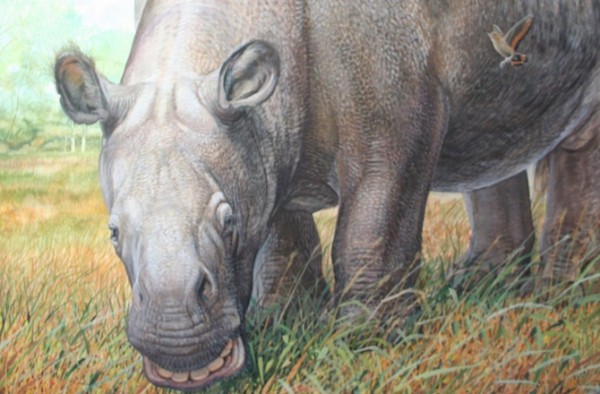Darwin's 'Strangest Animal in the World' Identified: Meet the Toxodon
| Ana Verayo | | Mar 19, 2015 08:23 AM EDT |
(Photo : Peter Schouten) The Toxodon platensis lived throughout the Pleistocene era where its fossils were found by Charles Darwin in Uruguay.
A new molecular analysis conducted on a 12,000 year-old fossil from the strangest animal ever discovered by Charles Darwin in South America has determined what this animal really is.
This protein study focused on ungulates native to Uruguay. Ungulates are a diverse group of mammals that have hooves and includes the Toxodon platensis, which is an elephant sized beast with a rhinoceros body type; a hippopotamus head and bizarre rodent teeth.
Like Us on Facebook
When Darwin discovered these creatures during his Beagle voyage, he was awestruck and recorded this in his 1839 account. He wrote how wonderfully different the animal orders are, which are blended together using different points of structure that makes up the toxodon.
At first Darwin suspected the unusual beast is a distant relative of rodents. Since then, other scientists have suggested the toxodon and its descendants are closely related to aardvarks and elephants.
This recent study conducted by Ian Barnes from London's Natural History Museum and his team, however, have confirmed these creatures are from a mammalian group called "condylarths".
Condylarths are closely related to perissodactyls, which are odd toed, hoofed mammals.
Researchers deciphered the ungulates' family tree by analyzing fragments of collagen proteins that were recovered from the Late Quaternary fossils of the creatures and also from other mammalian samples. This collagen is mostly found in connective tissue and is classified as structural protein.
These proteins can also be sequenced and studied like DNA signatures and they are more likely to be preserved in fossilized bones. This new research proves that proteins can also serve as an important key to unlocking more evolutionary mysteries.
This protein study was published online in the journal, Nature.
TagsDarwin's 'Strangest Animal in the World' Identified: Meet the Toxodon, charles darwin, strangest animal in the world darwin, toxodon, identified darwin strange mammal south america, south america
©2015 Chinatopix All rights reserved. Do not reproduce without permission
EDITOR'S PICKS
-

Did the Trump administration just announce plans for a trade war with ‘hostile’ China and Russia?
-

US Senate passes Taiwan travel bill slammed by China
-

As Yan Sihong’s family grieves, here are other Chinese students who went missing abroad. Some have never been found
-

Beijing blasts Western critics who ‘smear China’ with the term sharp power
-

China Envoy Seeks to Defuse Tensions With U.S. as a Trade War Brews
-

Singapore's Deputy PM Provides Bitcoin Vote of Confidence Amid China's Blanket Bans
-

China warns investors over risks in overseas virtual currency trading
-

Chinese government most trustworthy: survey
-

Kashima Antlers On Course For Back-To-Back Titles
MOST POPULAR
LATEST NEWS
Zhou Yongkang: China's Former Security Chief Sentenced to Life in Prison

China's former Chief of the Ministry of Public Security, Zhou Yongkang, has been given a life sentence after he was found guilty of abusing his office, bribery and deliberately ... Full Article
TRENDING STORY

China Pork Prices Expected to Stabilize As The Supplies Recover

Elephone P9000 Smartphone is now on Sale on Amazon India

There's a Big Chance Cliffhangers Won't Still Be Resolved When Grey's Anatomy Season 13 Returns

Supreme Court Ruled on Samsung vs Apple Dispute for Patent Infringement

Microsoft Surface Pro 5 Rumors and Release Date: What is the Latest?










